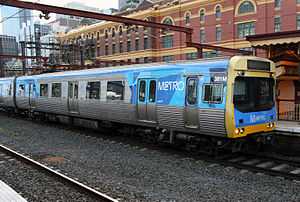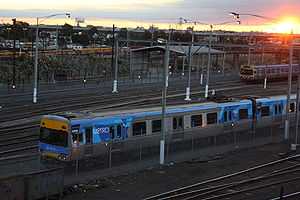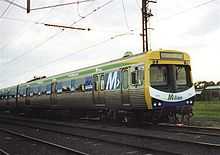Comeng (train)
| Comeng (Melbourne) | |
|---|---|
|
| |
|
| |
| In service | 1981–current |
| Manufacturer | Comeng |
| Built at | Dandenong |
| Replaced | Tait & Harris trains |
| Constructed | 1981–1988 |
| Entered service | 1981–present |
| Refurbishment | 2000–2003 Alstom, EDi Rail |
| Number built | 190 trainsets (570 cars) |
| Number in service | 186 trainsets (558 cars) |
| Number scrapped | 24 cars scrapped/stored due to accident damage |
| Formation | Three car set (Driving motor-trailer-driving motor, usually marshalled into 6-car sets |
| Fleet numbers | 301M–1001T–302M through 697M–1199T–698M |
| Capacity | 268 seated, 763 crush load per 3-car unit (Alstom refurbished)[1] |
| Operator |
Historically VicRail, MTA, PTC, Connex & M>Train Currently Metro Trains Melbourne |
| Depot(s) | All Metro Trains depots |
| Line(s) served | All Melbourne suburban (except Stony Point) |
| Specifications | |
| Car body construction | Stainless steel |
| Car length | 24 m |
| Width | 3 050 mm |
| Height | 3 827 mm (not including pantograph) |
| Articulated sections | 2 per 3-car set, open gangway |
| Maximum speed | 115 km/h (71 mph) |
| Weight | 141 t (max) |
| Acceleration | 0.8 m/s2 |
| Deceleration | 0.9 m/s2 |
| Electric system(s) | 1.5 kV DC Overhead line |
| Braking system(s) |
Westinghouse Westcode Tread Brakes (First order) Knorr-Bremse Disc Brakes (Second order) |
| Coupling system | Scharfenberg coupler |
| Track gauge | 1 600 mm (5 ft 3 in) Irish gauge |
The Comeng train is a type of electric train that operates on the suburban railway network of Melbourne, Australia. They first appeared on the network in VicRail teacup livery in 1981 to replace the last of the 60 year old Tait trains. More were ordered after the failed refurbishment and subsequent withdrawal of the Harris trains. In total 570 carriages (380 motor cars and 190 trailer cars, a total of 95 six carriage sets) were built by Comeng, Dandenong.
Description
The Comeng trains are single deck and are semi-permanently coupled as M-T-M (motor-trailer-motor) sets, but these sets spend much of their time coupled in pairs as six-carriage sets.
Comeng trains have power operated doors that must be pulled open by hand but are closed by the driver. The trains were the first suburban trains in Melbourne to have air-conditioning in the passenger saloon. (The older Hitachi trains having had driver only air-conditioning fitted more recently.[2])
The design of Melbourne's Comeng trains is closely related to that of TransAdelaide's diesel-electric 3000 class railcars.
Refurbishment
Between 2000 and 2003, the two train operators at the time, Connex and M>Train, had Alstom and EDi Rail respectively refurbish the trains.[3][4]
The Alstom and EDi Rail sets have a number of differences, including:
- Interior arrangement - The interior LED displays on the M>Train trains were in the middle, as opposed to being at both ends of the carriage on Connex sets.
- Upholstery - Seats in M>Train trains are blue, while Connex opted for rainbow-textured seats.
- Seating arrangement - Connex provided a different seating layout from M>Train.
- Exterior front panels - Information on the train's terminus is displayed on top of the window on M>Train fleets, while Connex trains have them displaying on the left window (in the pre-refurbishment style).
- Cab layout - The EDI Rail refurbished trains retained a second full-size seat on the right-hand side of the cab, originally used for the guard, whereas the Alstom sets only have a small seat, the same size as the passenger ones.
- Cab fittings - The EDi Rail trains also have a windscreen-wiper on both sides, the Alstom sets only having one on the driver's side.
- Light fittings - The Alstom refurbished trains have grated light coverings, while the EDi type retained the original flat coverings.
Both sets had CCTV and emergency assistance panels added as part of the refurbishment program.[5]
After Connex assumed responsibility for all of Melbourne's suburban train network in 2004, the EDi refurbished trains had the M>Train exterior logos removed, and later received Connex blue and yellow side stripes, and a repainted front panel.
Concorde Program
From December 2006 both fleets were allowed to run system wide. The electronics of both Comeng types were altered to make them electronically compatible with each other, with both the PID voices and display formatting altered. Both types of Comeng can run system wide and can run in multiple unit with trains of the same or different type.
Interior rearrangements
From the beginning of March 2009, Connex ran a test set of carriages with new seating arrangement on city lines.[6] The new arrangements removed 44 seats, making room for more standing on the train. The changes were made to accommodate the increased patronage on the Melbourne rail network.[7]
As part of its franchise agreement, Metro Trains Melbourne is required to modify the seating layout of all Comeng trains to have 2-2 seating which allows better passenger flow through the train and more standing room.
Stored carriages
12 Comeng carriages have been scrapped or removed from service.[1]
Eight carriages have been scrapped: 315M, 388M, 1165T, 1109T, 533M, 305M, 1003T and 306M. with 315M burnt out at Hurstbridge, 388M hit by V/Line locomotive N457 at Officer, 1165T burnt out at Northcote, 1109T damaged in a collision at Epping,[8] 533M was burnt out by vandals. Both 1109T and 533M were stored at the Ballarat Workshops and were scrapped in August 2010.[9] In November 2012, 305M, 1003T and 306M crashed into a truck at Abbotts Road in Dandenong South, Comeng 305M-1003T-306M are stored in Dandenong South for the permanent withdrawal and could be seen from the Cranbourne line. In May 2014 all 3 Cars were scrapped.
Another four carriages have been stored: 500M, 671M, 672M, and 1186T. 500M was burnt out at Sandringham in 2002[10] and can be seen in a yard close to the North Williamstown station side of the Newport railway workshops. 671M was partly burnt out at Gowrie. Spare cars 672M and 1186T underwent a prototype refurbishment before being stored.
In August 2014, the Comeng train 427M-1052T-487M was destroyed between Laverton and Newport near Galvin with lower front panels damaged and between carriages collided after being hit by V-Line's V'Locity train behind Comeng fleet and later stored to Newport Workshops.
Future Upgrades
The Comeng fleet is currently having new handles trialled to make it harder to force open doors, following an incident at Watergardens railway station where a teenager forced a door open while the train was moving.[11][12]
In popular culture
In the video clip "All Torn Down" by Melbourne band The Living End, the band is seen boarding an unrefurbished Comeng.
The unrefurbished Comeng also appears on the front cover of a Melbourne Hip Hop artist Fubex, his album was Upcoming.
Portions of the unrefurbished Comeng can be in scenes of 1990 film The Big Steal directed by Nadia Tass.
A refurbished Comeng can be seen in the background of a carriage scene on the TV series How I Met Your Mother Series 9 Episode 1 (set in New York)
Gallery
-

EDi Rail refurbished Comeng in Connex Livery at Tooronga station
-

Alstom refurbished Comeng in Metro Livery leaving Lilydale Station
-

M>Train Comeng in 2002
-
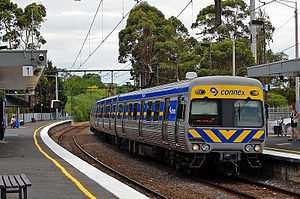
Comeng carriage refurbished by Alstom
-
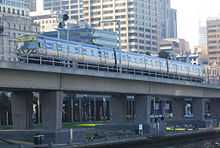
Alstom refurbished set departing Flinders Street
-
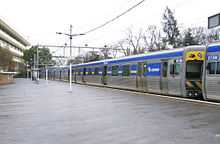
Alstom refurbished set at Flemington Racecourse
-

Burnt out unrefurbished Comeng 500M at Newport Workshops
-

Comeng plaque over carriage doors
-

EDi Rail refurbished set at Flinders Street
References
- ↑ 1.0 1.1 Vicsig: Comeng Trains
- ↑ Vicsig: Hitachi Trains
- ↑ Minister for Manufacturing Industry: '$150 Million Investment in Rail Manufacturing' - 17 August 2001
- ↑ Australian Railway Industry Corporation: EDI Rail
- ↑ Department of Infrastructure New and refurbished trains and trams
- ↑ "Commuters get to try new look Connex trains". 13 March 2009 (Herald Sun). Retrieved 2009-03-14.
- ↑ "Connex demonstrates a new train layout". 12 March 2009. Connex Melbourne. Retrieved 2009-03-14.
- ↑ Vicsig: Comeng-1109T
- ↑ Vicsig: August 2010 scrappings
- ↑ Vicsig: 500M burnt out at Hampton
- ↑ Rail page Australia http://www.railpage.com.au/f-t11377348.htm
- ↑ "Ageing trains targeted by vandals and Transport safety Victoria". The age. 14 March 2014.
External links
| Wikimedia Commons has media related to Comeng (train). |
| ||||||||||||||||||||||||||||||||||||||||||||||||||||||||||||||||||||||||||||||||||||||||||||||||||||||||||||||||||||||
